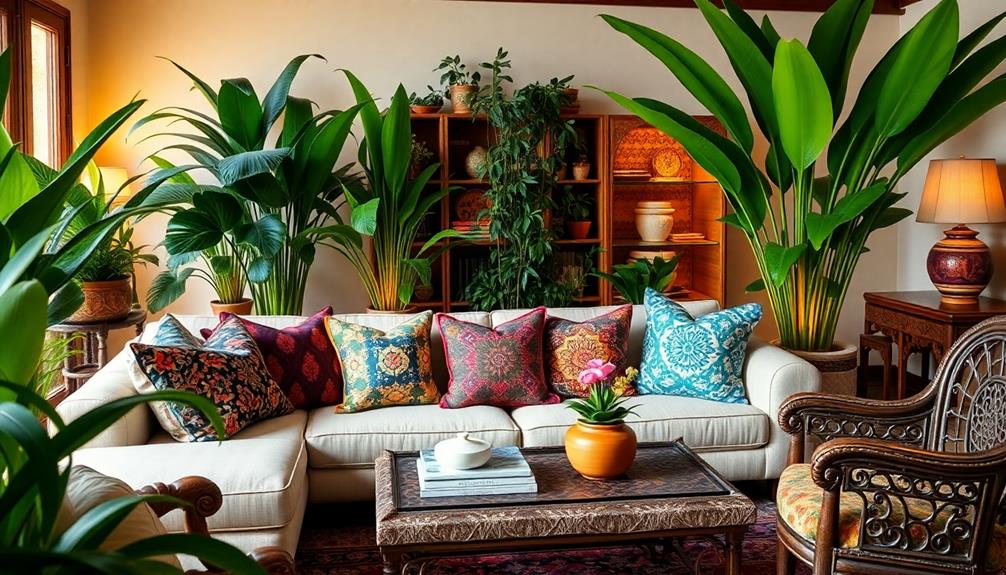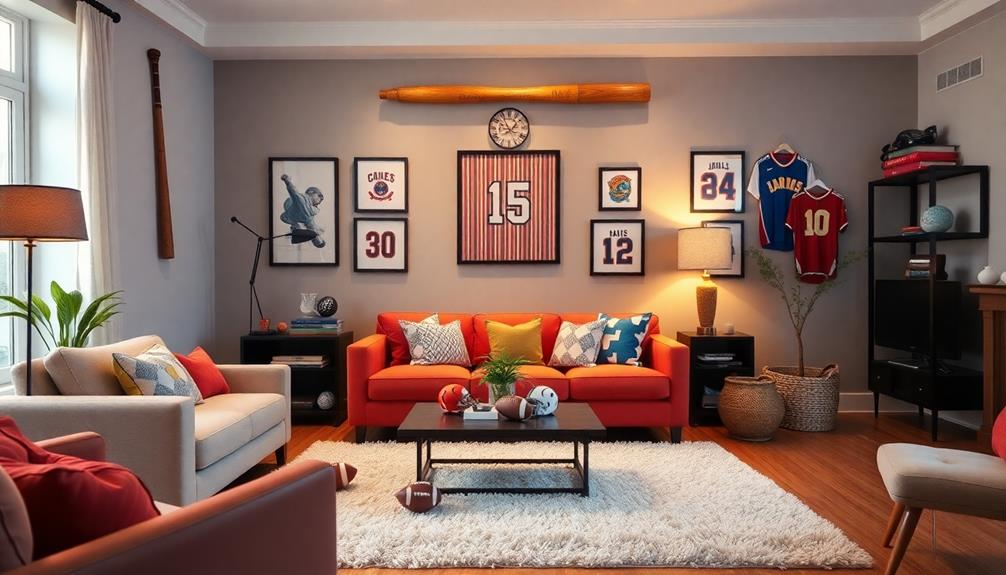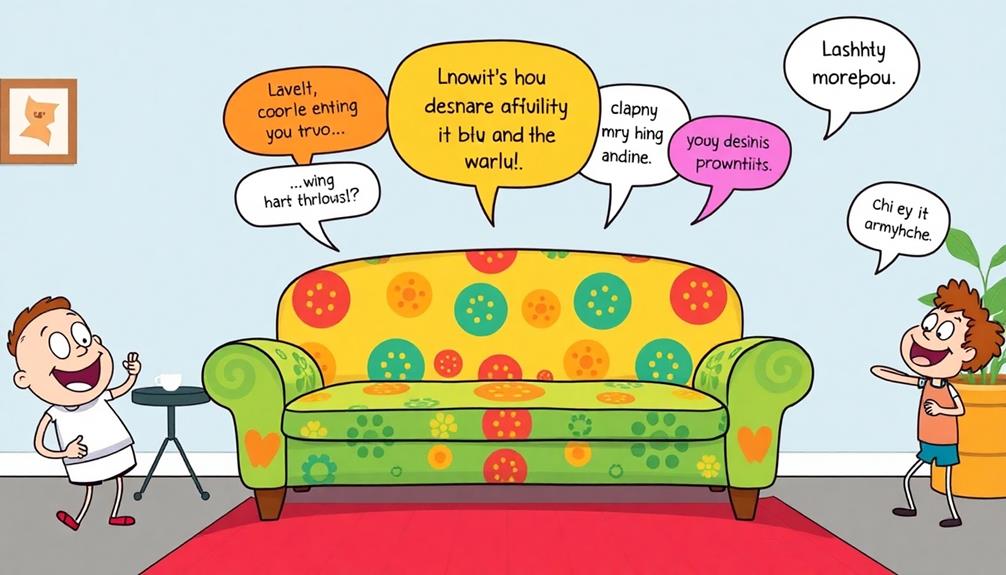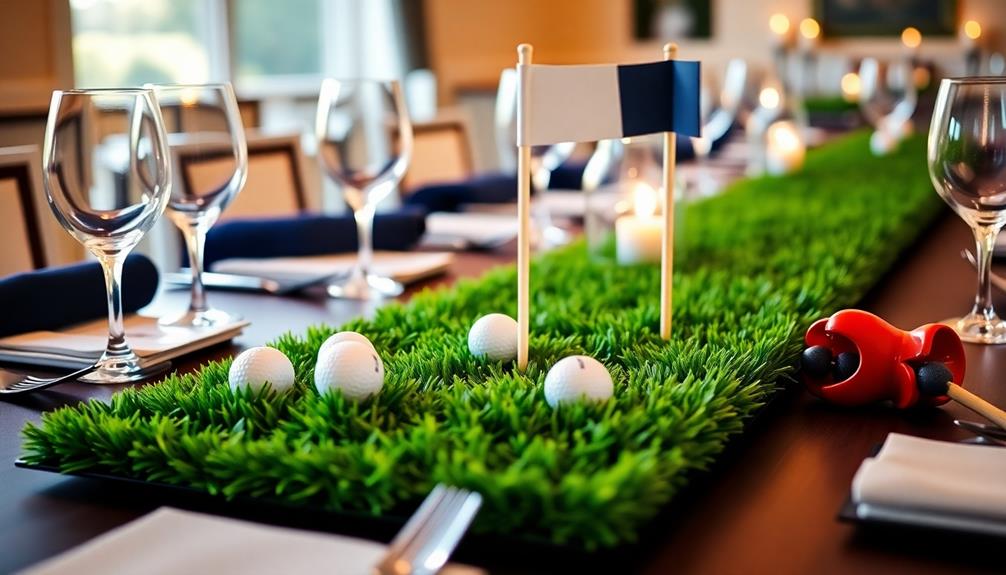To mix Indonesian fabrics for a bold yet balanced interior, start with a striking Batik or Ikat piece as your focal point. Choose vibrant colors like deep blue or warm orange, and pair them with neutral shades to anchor the look. Integrate diverse textures by layering lightweight batik with heavier materials, creating depth. Limit your patterns to three or four varying in scale to maintain cohesion. Finally, embrace the stories behind these fabrics, celebrating their cultural significance. There's plenty more to explore about achieving a harmonious atmosphere using Indonesian textiles.
Key Takeaways
- Start with a striking Batik or Ikat piece as the focal point to set the tone for your design.
- Balance bold patterns with neutral shades like cream or soft beige to create a harmonious look.
- Limit your mix to three or four patterns of varying scales for visual cohesion and interest.
- Incorporate natural materials like wood and stone to resonate with traditional Indonesian styles and enhance texture.
- Experiment with layering different textures, such as silk and cotton, to add depth and richness to your interior.
Understanding Indonesian Fabric Characteristics
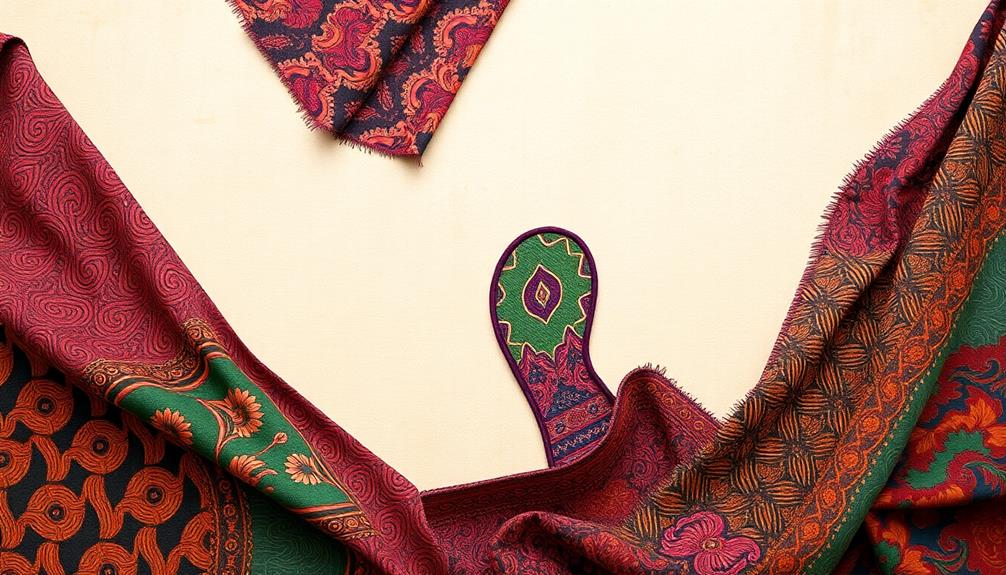
When you explore Indonesian fabrics, you'll discover that their characteristics are both rich and varied. Batik and Ikat, two of the most famous types, showcase intricate patterns that often tell unique cultural stories.
Batik employs a wax-resist dyeing technique, creating detailed designs that can be both symmetrical and asymmetrical. This method allows for stunning visual depth, perfect for adding character to your space. Additionally, incorporating unique artistic expressions from Indonesian decor masks can further enhance the cultural richness of your interior.
On the other hand, Ikat features a distinctive dyeing process where the yarns are dyed before weaving, resulting in blurred patterns that weave texture into your interiors. Both fabric types utilize natural materials like cotton and silk, ensuring durability and comfort while promoting sustainable practices.
When it comes to the color palette, Indonesian textiles shine with their bold hues. You can create striking focal points by layering these fabrics within a balanced design scheme.
As you mix and match, keep in mind how the patterns go together; the harmony between both the intricate designs and colors will elevate your interior, making it not just visually appealing but also culturally enriching. Embrace these characteristics to create a unique space that reflects your personality.
Selecting an Inspiring Fabric Piece
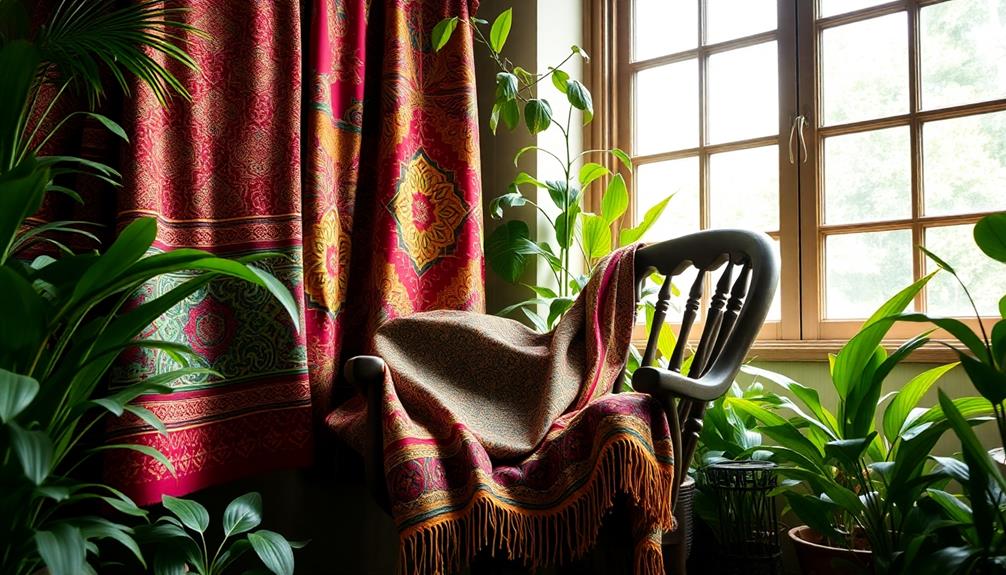
Choosing the right fabric piece can set the entire tone for your interior design. Start with a striking Indonesian fabric like Batik or Ikat as your inspiration. This piece should feature a color palette that harmonizes with your existing furniture and decor, creating a cohesive look throughout your space.
Consider incorporating Indonesian Decorative Pillows that can enhance the visual appeal and comfort of your room.
Look for a fabric that incorporates a mix of bold patterns and subtle elements. This versatility allows you to pair it with other fabrics seamlessly. Pay attention to the scale of the patterns; larger prints can serve as focal points, while smaller patterns can complement them without overwhelming the room.
Additionally, consider selecting a fabric that embodies cultural significance or tells a story. This enriches your design narrative, adding depth and character to your interior.
Remember that the right fabric can influence the overall atmosphere of your home, making it feel inviting and unique. By thoughtfully choosing your inspiration piece, you're laying the foundation for a beautifully curated interior design that reflects your personal style and appreciation for Indonesian textiles.
Color Palette Creation
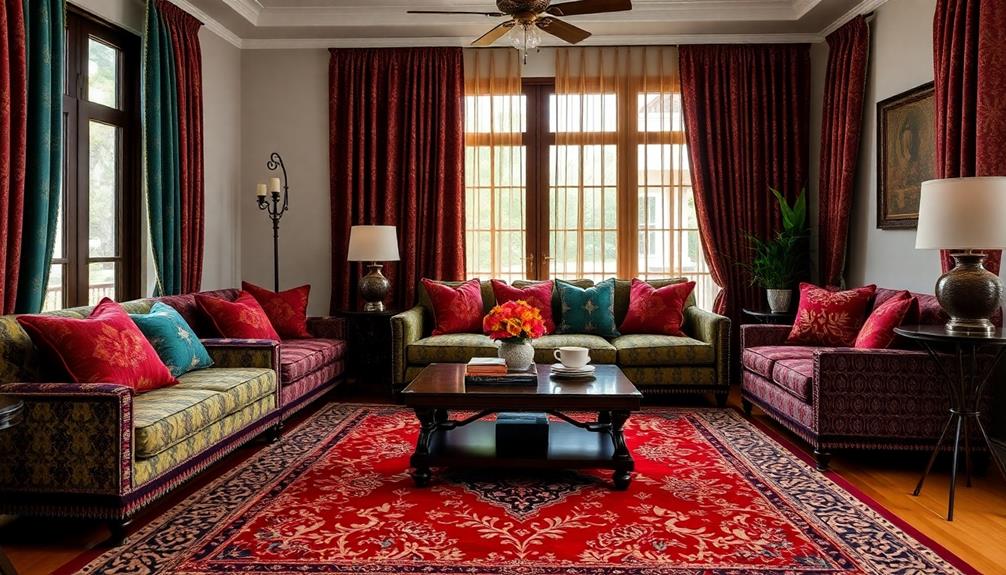
To create a stunning color palette, start by choosing a main color from Indonesian fabrics, like deep indigo or warm terracotta.
These vibrant hues reflect rich Indonesian culture and can be complemented with traditional artistry in decor, enhancing the overall aesthetic.
Next, incorporate neutral shades such as cream or soft beige to balance out the bold hues and let your patterns shine.
This thoughtful combination will set the stage for a cohesive and inviting interior design.
Choosing Main Colors
Indonesian fabrics boast a stunning array of vibrant hues, making them perfect for infusing your interior design with energy and character. These textiles often reflect the rich cultural heritage of Indonesia, which can be beautifully complemented by decor pieces like Indonesian decor masks that enhance the aesthetic appeal of your space.
To create a dynamic color palette, start by selecting at least two main colors that resonate with the deep reds, rich blues, or earthy greens often found in these fabrics. These bold colors will set the tone and draw attention to your space.
Next, consider incorporating a neutral color like cream or light gray. This balance helps the intricate patterns of Indonesian textiles stand out without overwhelming the room. Additionally, think about using a third accent color derived from existing Indonesian motifs; this will enhance harmony and tie your overall design together.
Consistency is key, so choose textiles that share similar tones or undertones across different patterns. This creates a cohesive look that unifies your decor.
Don't shy away from using contrasting colors purposefully; they can create visual interest and complement the detailed designs typical of Indonesian textiles. By carefully choosing your main colors, you'll guarantee your interior feels both bold and balanced.
Incorporating Neutrals Effectively
A well-chosen neutral base is essential for effectively incorporating vibrant Indonesian fabrics into your interior design. Start with a neutral foundation like cream or light gray to anchor the colorful patterns that these textiles offer. This sets the stage for a balanced look and allows the bold designs to shine without overwhelming the space.
To enhance the aesthetic further, consider using natural materials like wood and stone, which resonate with traditional Indonesian style home decor and add texture to your design.
Next, select at least two main colors inspired by the intricate motifs found in Indonesian fabrics. These colors should introduce variety and depth while harmonizing with your neutral base. Incorporating a third color that reflects existing furniture or decor elements will create cohesion throughout the room, enhancing the overall aesthetic. If you have existing furniture or decor elements with tropical-inspired patterns or colors, incorporating a third color from these elements can help tie the room together. For example, if you have a statement tropical-printed chair, you might consider pulling a color from that print to use as an accent in your color scheme. Additionally, consider incorporating tropical centerpiece ideas, such as palm fronds or vibrant floral arrangements, to bring a touch of Indonesian-inspired nature into the space. These elements can further enhance the overall aesthetic and tie the room together. Lastly, consider adding some tropical table decor ideas to your space to further enhance the Indonesian-inspired aesthetic. Incorporating elements like woven placemats, bamboo utensils, or colorful glassware can create a cohesive and authentic tropical feel. Additionally, consider adding a pop of color with tropical-themed table linens or vibrant table runners to bring the whole look together. These small details can make a big impact and truly transport your space to a tropical paradise.
Consistency is key, so make sure the chosen hues are repeated across different fabric patterns. This repetition fosters a unified look that ties the room together.
Don't shy away from using contrasting colors strategically; they can add visual interest and make the vibrant patterns pop. Just make certain these contrasts complement the overall design, maintaining the balance between boldness and harmony.
Mixing Patterns for Visual Interest
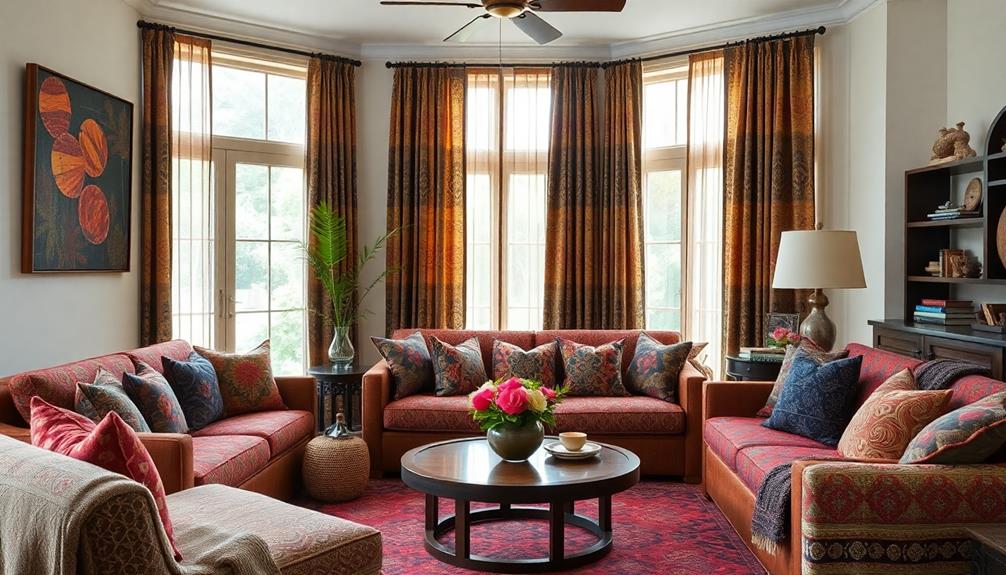
Incorporating various patterns can truly elevate your interior design, especially when mixing Indonesian fabrics. Start with a bold batik print as your hero pattern; it'll serve as the focal point of your design. This vibrant choice can draw the eye, setting the tone for your overall aesthetic.
To enhance the style, consider using natural materials, such as wood and bamboo, which are prominent in Balinese design characteristics. Next, balance it out by introducing smaller geometric patterns, like ikat or woven textiles. These subtle designs add visual interest without overwhelming the space.
To maintain harmony, stick to three or four distinct patterns, ensuring each varies in scale. This variety creates a dynamic yet cohesive look that keeps the eye engaged. A cohesive color palette is essential, too. Choose hues that reflect the rich colors found in Indonesian textiles, allowing patterns to complement one another through shared tones.
Don't forget about texture! While this subtopic focuses on mixing patterns, consider how lightweight cotton batiks can pair beautifully with heavier silk or wool fabrics. This combination adds depth and dimension to your space, enhancing the visual appeal.
Incorporating Diverse Textures
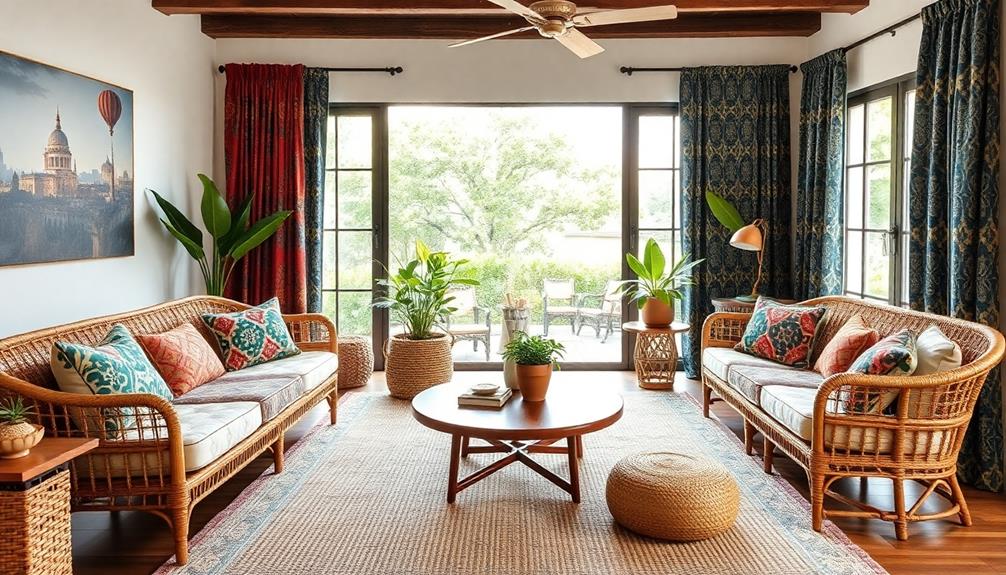
Mixing patterns creates visual interest, but the true magic of interior design lies in the textures you choose. By incorporating diverse textures, you can elevate your space, making it both inviting and visually enchanting.
Indonesian fabrics like batik, ikat, and songket offer a rich tapestry of textures that can enhance your home's aesthetic, much like the unique characteristics of traditional Indonesian housing that reflect regional identity and cultural symbolism.
Here are three tips for effectively mixing textures:
- Layering: Combine heavier textures like songket with lighter fabrics such as batik. The contrast adds depth and visual intrigue while maintaining a balanced look.
- Mixing Weaves: Pair smooth cottons with the rougher weaves of ikat. This juxtaposition creates a dynamic feel, ensuring your design isn't flat or monotonous.
- Cohesive Color Palette: As you mix patterns and textures, maintain a consistent color scheme. This harmony allows the diverse elements to complement one another rather than clash, resulting in a well-balanced interior.
Building Confidence in Design Choices
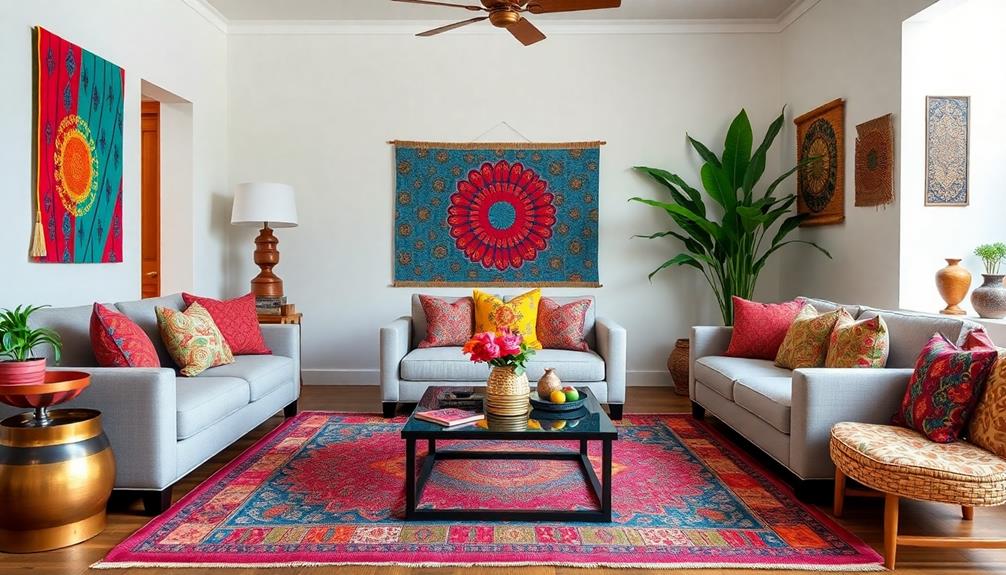
Embracing the vibrant world of Indonesian fabrics can greatly boost your confidence in design choices. By experimenting with bold and busy patterns like batik and ikat, you can create an eclectic yet harmonious space. Start with a striking batik as your hero pattern, then layer in complementary ikat and solid fabrics. This mix reflects your unique style while maintaining balance.
To help you visualize your options, check out the table below:
| Fabric Type | Color Example |
|---|---|
| Bold Batik | Deep Blue |
| Complementary Ikat | Warm Orange |
| Solid Neutral | Soft Beige |
Visiting local fabric markets lets you physically handle these textiles, enhancing your understanding of how patterns interact. Remember the 60-30-10 color rule: let your bold patterns shine while balancing them with neutral tones. Layer different textures, from silk to cotton, to add depth and showcase the richness of Indonesian textiles. This practice not only enhances your space but also solidifies your confidence in mixing patterns. So go ahead—embrace boldness, and let everything else fall into place!
Frequently Asked Questions
How to Mix and Match Fabrics?
When you mix and match fabrics, start with a standout piece. Choose complementary patterns in varying scales, stick to a cohesive color palette, and limit yourself to three or four designs for a harmonious look.
How to Mix Patterns in Interior Design?
Mixing patterns in interior design is like orchestrating a symphony. Start with a strong foundation, blend different scales, and maintain a cohesive color scheme. Limit your designs to three or four for harmony and balance.
How Do You Mix Fabric in Living Room Furniture?
To mix fabric in your living room furniture, start with neutral bases for larger pieces, then introduce bolder patterns on accents. Layer different textures and guarantee a cohesive color palette for a harmonious look.
Can You Mix Toile Patterns?
You can mix toile patterns beautifully. Imagine pairing a large floral toile with smaller geometric prints and a solid color. Keep a consistent color palette, and you'll create a harmonious, eye-catching space that feels balanced.
Conclusion
Mixing Indonesian fabrics can transform your space like a vibrant tapestry woven with stories. By understanding fabric characteristics and selecting inspiring pieces, you can create a bold yet balanced interior. Embrace color palettes, mix patterns, and incorporate diverse textures to craft a visually enchanting environment. Remember, confidence in your design choices is key; trust your instincts and let your creativity flow. Immerse yourself in the art of mixing, and watch your interior come alive!
